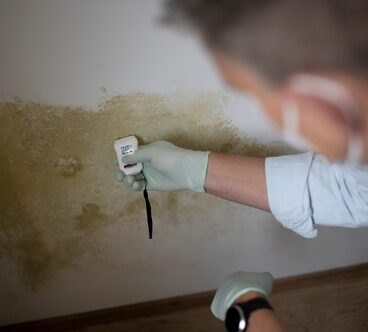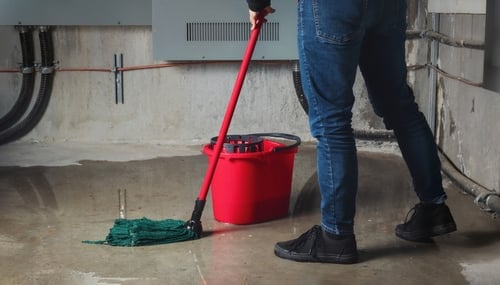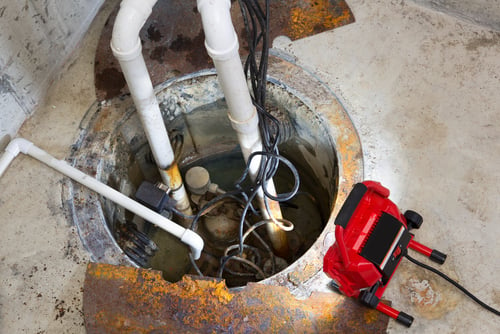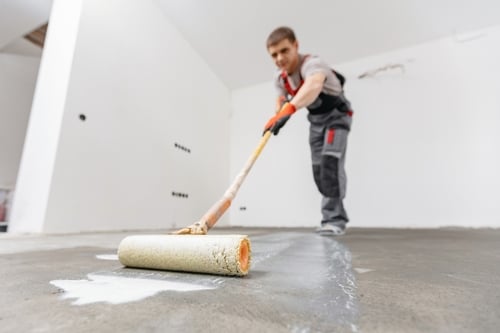Are you aware that a silent intruder could lurk beneath your rental property, silently wreaking havoc on its value and your tenants’ well-being? Often unseen and insidious, water damage can chip away at your property’s integrity by decreasing its value by 10-20%. As a landlord, staying proactive against this hidden threat and knowing how to assess water damage is not just a matter of preserving your investment—it’s a protection for your tenants’ safety and satisfaction.
 Imagine this scenario: Your tenants notice a faint, musty odor lingering in the basement. Initially dismissed as mere dampness, it could be the early warning sign of a much larger problem brewing beneath the surface. Ignoring such signs could lead to costly repairs and the risk of losing valuable tenants who seek a drier abode elsewhere.
Imagine this scenario: Your tenants notice a faint, musty odor lingering in the basement. Initially dismissed as mere dampness, it could be the early warning sign of a much larger problem brewing beneath the surface. Ignoring such signs could lead to costly repairs and the risk of losing valuable tenants who seek a drier abode elsewhere.
This guide will delve into the common signs of moisture issues and essential steps landlords must take to assess and manage water damage in their rental property basements. By staying ahead of the curve and arming yourself with knowledge, you can fortify your property against this silent adversary, ensuring its longevity and the well-being of your tenants.
Identifying Common Signs of Basement Water Damage
Unseen water damage is insidious, often undetected until significant issues arise. It can wreak havoc on rental properties, posing serious threats to structural integrity and tenant health. The first step in managing water damage is being able to recognize it. Below are common signs to look for:
-
Musty Odors
A musty odor in your basement is one of the earliest moisture issue indicators. This smell, often described as damp or stale, is usually the result of mildew or mold growth that thrives in moist environments. It can persist even in ostensibly dry conditions because the problem may be hidden behind walls or under flooring.
Such odors should not be ignored, as they signify that water is intruding somewhere, creating an ideal habitat for mold and mildew growth. Addressing this issue promptly can prevent more significant damage and health risks associated with mold exposure.

-
Water Stains on Walls and Floors
Water stains on your basement walls or ceilings are clear visual indicators of water damage. These stains can appear as discolored patches or spots, which may grow over time. They often indicate water seepage through the foundation or leaks from pipes concealed behind the walls. Ignoring these stains can lead to the deterioration of structural materials and promote mold and mildew growth. Early detection and repair of the water source are vital to prevent further damage.
-
Mold Growth
Mold is unsightly and a health hazard, triggering allergies, respiratory problems, and other adverse health effects. When mold spores find a damp spot in your basement, they can quickly grow and spread. Visible mold growth, particularly in corners, on walls, or near any plumbing fixtures, is a clear sign of excessive moisture and water damage.
Various shades of mold, ranging from black and green to white and orange, can indicate different moisture levels and the extent of the water damage. Immediate action is necessary to remove the mold and rectify the source of moisture.
-
Foundation Cracks and Damage
Over time, water damage can severely affect the foundation of your property. Cracks in the foundation may appear small initially but can widen, leading to significant structural issues. These cracks often result from water seeping into the foundation, expanding upon freezing and creating larger fissures. Foundation damage can compromise the overall integrity of your property and requires immediate attention to prevent catastrophic failure.
-
Standing Water
Visible water is the most obvious sign that you have a water intrusion problem. Puddles or pools of water in your basement, no matter how small, can lead to severe structural issues and are a pressing concern that must be dealt with immediately. It can result from many factors, including leaks in your foundation, improperly sealed windows, or ineffective drainage around your property.
Standing water causes immediate damage to flooring and belongings and increases humidity levels, encouraging mold and mildew growth. Quick actions to remove the water and address its source are critical steps in mitigating damage.
Being vigilant and knowledgeable about the common signs of water damage in your basement is indispensable for any landlord. Early detection and appropriate intervention can save you from facing extensive repairs and a loss of property value and ensure the health and comfort of your tenants.
Step-by-Step Process for Assessing Basement Water Damage
After knowing the signs of water damage in your basement, it’s crucial to conduct a thorough assessment to understand the extent and source of the issue. This step-by-step process ensures no detail is overlooked, allowing for an effective resolution strategy.
 Step 1: Visual Inspection
Step 1: Visual Inspection
Begin your assessment with a comprehensive visual inspection of the basement. Look for the signs we’ve just discussed, such as staining on walls, ceilings, and floors, musty odor, cracks, standing water, and leaks. Pay close attention to corners and areas around windows and doors, as these are common entry points for water.
Don’t forget to examine hidden areas behind furniture or stored items where damage might be less apparent. This step can help identify the most affected areas and potential entry points for water.
Step 2: Checking for Moisture
Use a moisture meter to check the humidity levels in different parts of the basement. These devices can help pinpoint areas with excessive moisture, indicating potential water intrusion sites. Pay special attention to spots near windows, doors, and places where walls meet the floor, as water often seeps in from the foundation. Understanding the moisture distribution can guide further inspection and remediation efforts.
Step 3: Examining Foundation Walls
Carefully inspect the foundation walls closely for any signs of cracks, fissures, weaknesses, or signs of water intrusion. Even small cracks can be pathways for water, leading to more significant issues over time. Press on suspected areas to check for softness, which indicates ongoing water damage. Mapping out the location and size of cracks can help you monitor changes over time.
Step 4: Inspecting Basement Fixtures
Evaluate all basement fixtures, including windows, doors, vents, and plumbing, to ensure they are sealed correctly and functioning as intended. Check for any gaps, leaks, or malfunctioning parts that could allow water to enter the basement. This includes assessing window wells for proper drainage and the cover’s integrity. Also, check any signs of rust or corrosion on metal fixtures, as these can be indicators of prolonged exposure to moisture.
 Step 5: Assessing Sump Pump and Drainage Systems
Step 5: Assessing Sump Pump and Drainage Systems
Finally, inspect the sump pump and overall drainage system for functionality and efficiency. Ensure the sump pump operates correctly, and the discharge line is clear, directing water away from the foundation. Also, verify that gutters and downspouts are intact and routed correctly to prevent water accumulation near the basement.
Documenting Water Damage Findings and Taking Action
In managing rental properties, documenting every aspect of inspections is vital after assessing the water damage. This process serves as a baseline for understanding the current condition of your property and facilitates decision-making for necessary repairs or enhancements. Detailed records enable property managers to track changes over time, pinpointing areas that may require more frequent attention. Documentation also plays a crucial role in legal and financial affairs, providing tangible evidence of the property’s state and the proactive measures taken to maintain it.
1. Documenting Observations
Following thorough inspections, the initial step is to document all observations meticulously. This includes taking detailed notes and photographs of any signs of wear, damage, or potential issues within the property. Property managers can efficiently prioritize repairs and maintenance tasks by recording the precise location, size, and severity of problems.
This documentation serves as a communication tool between property managers, landlords, and contractors, ensuring alignment regarding the property’s condition and planned interventions. Additionally, it aids in monitoring the progression of any noted concerns over time, enabling timely interventions.
2. Consulting Professionals in Property Maintenance Management
Consulting with professionals in basement waterproofing services is often necessary to identify the root causes of water intrusion and ensure long-lasting protection for the property’s foundation. Their expertise allows for an in-depth analysis of the situation, followed by recommendations and implementation of practical solutions tailored to the property’s specific needs. Engaging such professionals not only ensures the quality and durability of repairs but also prevents future issues, safeguarding the property’s value and livability.
 3. Implementing Preventative Measures
3. Implementing Preventative Measures
Beyond immediate repairs, implementing preventative measures is key to maintaining the integrity and value of rental properties. Partnering with a dedicated rental property management specialist who understands maintenance needs is advisable. They can conduct regular maintenance checks, identify potential problems before they escalate, and recommend actions to mitigate risks.
Their expertise in property management ensures that your property is not only reactive to issues but also proactive in preventing them, demonstrating a commitment to the property’s long-term health and the satisfaction of tenants.
Final Thoughts
Effectively managing a rental property demands a proactive stance toward preventing basement water issues, meticulous documentation, and timely professional intervention. Partnering with experienced property managers and basement waterproofing services is paramount to ensuring the security and profitability of your investment. Remember, the effort and resources dedicated to maintaining and safeguarding your property today can spare you from enduring significant financial losses and legal complications in the future.
Furthermore, fostering a strong relationship with your tenants by educating them on the importance of promptly reporting leaks or moisture issues can play a pivotal role in water damage prevention. It’s an investment in your property’s future, as well as in the safety and satisfaction of your tenants. By adopting these measures, you safeguard not only your property’s structural integrity but also its value in the competitive real estate market.
 Meet the Author
Meet the Author
Alex Stieb, the Owner of LUX Foundation Solutions, is a leading provider of basement waterproofing, foundation, and crawl space repair services for both residential and commercial properties in Northern Virginia and beyond. With a wealth of experience as a certified and licensed foundation repair specialist, Alex is dedicated to ensuring his clients dry, healthy, and structurally sound homes and businesses. His team has a strong commitment to excellence and continually updating expertise in the field, making his team a trusted resource for all your waterproofing, foundation repair, and crawl space repair needs.

 Step 1: Visual Inspection
Step 1: Visual Inspection Step 5: Assessing Sump Pump and Drainage Systems
Step 5: Assessing Sump Pump and Drainage Systems 3. Implementing Preventative Measures
3. Implementing Preventative Measures Meet the Author
Meet the Author